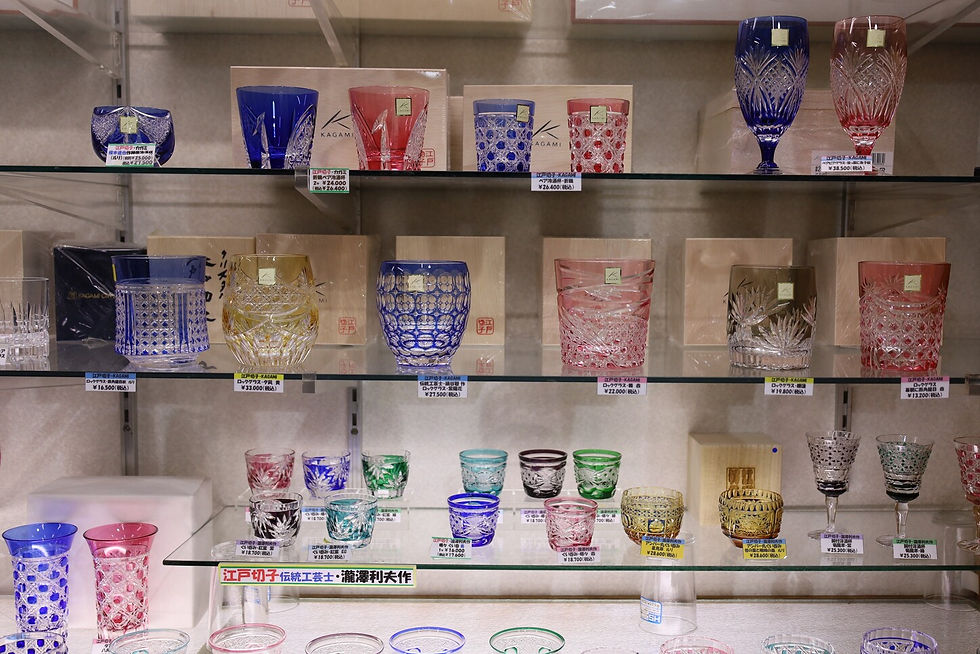Episode 2: Insights from a Kagurazaka Store Owner – The History and Evolution of Toushien Pottery Shop in Tokyo
- Shinya Yamada
- Dec 16, 2024
- 3 min read
Updated: Mar 8

Kagurazaka Store Owner Interview Series
In the second installment of our Kagurazaka store owner Interview series exploring the charm of Kagurazaka’s shopping district, we spoke with Nobutaka Tatebayashi, the second-generation owner of Toushien, a historic pottery shop. From the kilns of Hasami Town in Nagasaki Prefecture to the vibrant streets of Kagurazaka, Mr. Tatebayashi has continuously adapted to the changing times with flexibility and determination. Here, we share his inspiring journey.

The Founding and History of Toushien
Toushien was established in 1946 in Shintomi, Chuo Ward, Tokyo, by Takuji Tatebayashi, a native of Arita Town in Saga Prefecture, where his family operated a porcelain wholesaler. In 1948, the shop relocated to Kagurazaka, where it has built an 80-year legacy. The name "Toushien" reflects the close bond between the founder and his childhood friend, the 13th-generation Sakaida Kakiemon, a renowned Arita porcelain artist.

In 1977, Mr. Nobutaka Tatebayashi and his wife moved to Kagurazaka to take over the business. Moving to a new city without prior connections was daunting, but the support of fellow members of the local merchants' association proved invaluable. “My Nagasaki dialect might be a bit hard to understand,” he jokes, showcasing both his humor and the resilience that has carried him through challenging times.



Deep Ties to Hasami Ware
Around 70% of Toushien’s tableware selection comprises Hasami ware, a reflection of Mr. Tatebayashi’s roots. Born as the third son of the historic Hasami kiln "Ichiryu Toen," founded in the late Edo period (1603-1868), he maintains strong ties to his hometown.
For example, he shares a close friendship with Morisuke Kodama, chairman of Saikai Toki, the company credited with making Hasami ware a national name in Japan. His brother, Masata Ichinose, served as the mayor of Hasami Town for 24 years, continuing the family’s legacy of leadership.

Adapting to Changing Times
Toushien underwent several significant transformations under Mr. Tatebayashi’s leadership. In the late 1970s, the business shifted rapidly from Hanpu-kai (subscription sales) to retail. “Households already had enough tableware, making subscription sales obsolete,” he explains. At the time, subscription sales accounted for 80% of the store’s revenue, making this shift a major challenge.

Fortunately, the couple’s experience in pottery manufacturing, wholesaling, and retailing, including work in department stores, helped them navigate this crisis.
Additionally, Toushien diversified its inventory by introducing glassware. For instance, when KAMEI GLASS, a major glass wholesaler, closed in 1997, Mr. Tatebayashi acquired a large stock of Satsuma Kiriko glass. This bold move expanded the shop’s offerings, establishing it as one of the top destinations for Edo Kiriko glass. “Edo Kiriko is well-known internationally as a Japanese craft and is often purchased as a souvenir,” he says. Flexibility and decisive leadership remain core strengths of Toushien.



The Importance of Change and Effort
“Over the past 25 years, around 90% of pottery retailers in Japan have closed due to online shopping and tax rebate programs,” Mr. Tatebayashi explains. “To survive, we need to adapt and continue making efforts.” Recently, his son has introduced new products, such as sauna goods, demonstrating the store’s ongoing innovation.

Popular Items Among International Visitors
Hasami ware, Kutani ware, matcha bowls, and single-flower vases, all of which evoke a sense of “Japanese tradition,” are particularly popular among international customers. Small items like Hashi-oki (chopstick rests) and figurines of beckoning cats also attract attention. Western-style tableware, such as Noritake’s "Totoro" series, has gained a dedicated following. Sake cups are another favorite, often purchased in bulk by Japanese sake enthusiasts.


Toushien: Honoring Tradition and Embracing Innovation
Through the interview, it became clear that Mr. Tatebayashi’s ability to honor tradition while embracing change is at the heart of Toushien’s success. His dedication to Hasami ware and his commitment to serving customers with sincerity have supported the store’s history and future.

Visit Toushien
After reading this article, why not visit Toushien and experience the charm of Japanese pottery firsthand? Engaging in meaningful conversations with Mr. Tatebayashi, who believes in “helping people buy the best Japanese products,” offers a unique shopping experience that online stores cannot replicate.
Even if you’re not fluent in Japanese, you can enjoy exploring Kagurazaka with one of our English-speaking guides. After learning about the history and culture of the area, visit Toushien and discover the differences between Arita ware and Hasami ware directly from Mr. Tatebayashi. Your pottery shopping experience will become even more enjoyable!

Store Information: Toushien
Website: toushien.net Search "Kagurazaka Toushien" online.
Address: 2-12 Kagurazaka, Shinjuku, Tokyo
Hours: Tuesday–Saturday 10:00 AM–7:00 PM / Sunday & Holidays 12:00 PM–6:00 PM
Closed: Mondays (or the following day if Monday is a holiday)

Book Each Experience
How to Access Kagurazaka
The Kagurazaka area is conveniently located within 30 minutes from any major station in Tokyo. This is because Kagurazaka is situated in the heart of Tokyo, at the center of the Yamanote Line. Please come and visit this convenient and charming Kagurazaka.








Comentarios